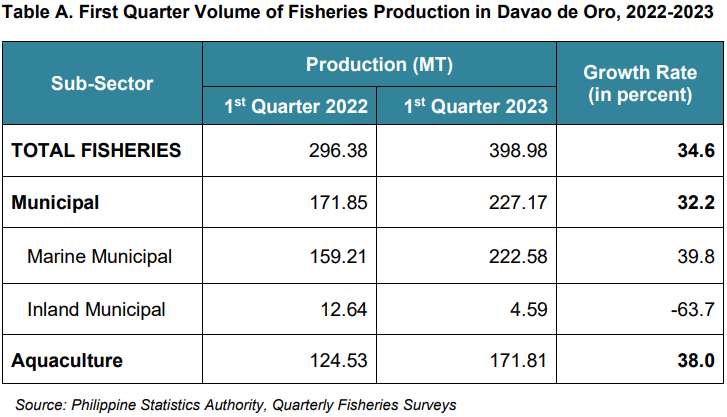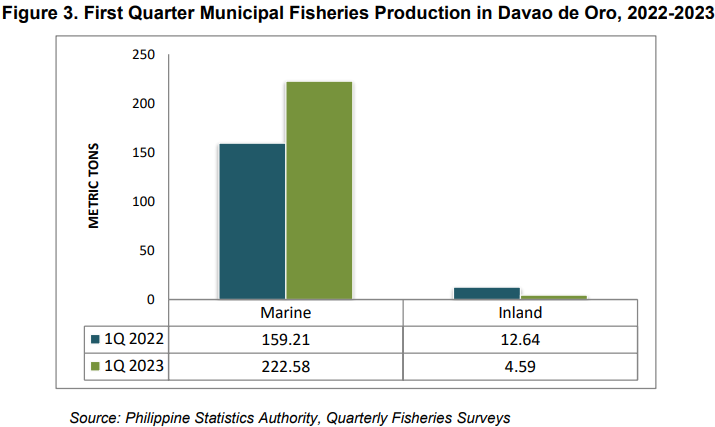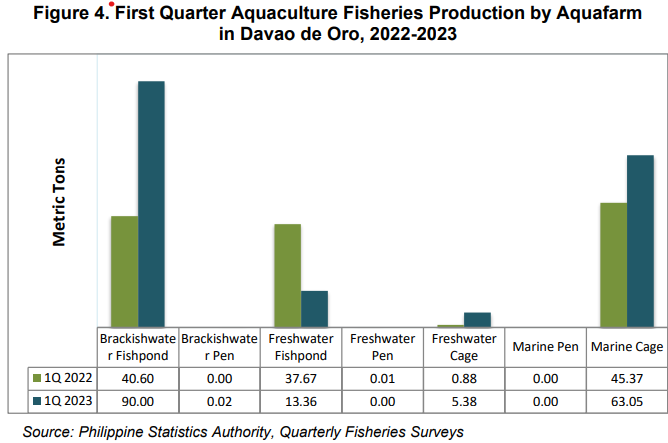Total volume of fisheries production grows by 34.6 percent
The total fisheries production in Davao de Oro during the 1st Quarter of 2023 reached 398.98 metric tons, marking a significant 34.6 percent increase from the 296.38 metric tons recorded during the same quarter last year. The growth can be attributed to increased production in both the Marine and Aquaculture sectors. (Table A)


The volume of fish production in Davao de Oro is attributed to three sub-sectors: commercial, municipal, and aquaculture. However, it's important to note that commercial fisheries are not applicable in Davao de Oro, as the province does not have any commercial fishing operations.

In the 1st quarter of 2023, municipal fisheries, which encompass both marine and inland fishing, constituted 57.0 percent of the total fisheries production. Within this category, marine municipal fishing represented 55.8 percent of the volume, while inland fishing contributed 1.2 percent. The remaining 43.1 percent was attributed to aquaculture
Municipal fisheries production marks a 32.2 percent increase
The volume of production of municipal fisheries in Davao de Oro includes both marine and inland municipal productions. During the 1st Quarter of 2023, the total production reached 227.17 metric tons. This marked a 32.2 percent increase compared to the same quarter in 2022 when the production was 171.85 metric tons.

In the 1st Quarter of 2023, the province’s marine municipal production saw a significant increase of 39.8 percent compared to the same quarter of the previous year. It rose from 159.21 metric tons in 2022 to 222.58 metric tons in 2023. Meanwhile, inland municipal production experienced a decline of -63.7 percent, decreasing from 12.64 metric tons in 2022 to 4.59 metric tons in 2023.
Bali Sardinella still tops in marine municipal fisheries production
In the 1st Quarter of 2023, the top three species caught in marine municipal fishing were Bali Sardinella, Frigate Tuna, and Squid. Bali Sardinella was the most frequently caught species, with a total of 48.32 metric tons, followed by Frigate Tuna with 27.63 metric tons, and Squid with 23.30 metric tons. Bali Sardinella experienced a remarkable growth rate of 350.0 percent compared to last year's catch of 20.81 metric tons. Similarly, Frigate Tuna saw a substantial increase in volume by 132.2 percent, rising from 6.14 metric tons to 27.63 metric tons this quarter. Squid also displayed a positive growth rate, contributing 23.30 metric tons to the production.

Aquaculture production expands by 38.0 percent
The volume of production on Aquaculture fisheries in the province posted a positive growth of 38.0 percent in the 1st Quarter of 2023. From 124.53 metric tons recorded in the 1st Quarter of 2022, it increases to 171.81 metric tons in 2023.
From the aquaculture subsectors, only freshwater fishpond was observed to have a negative growth, when compared to the previous year. Freshwater fishpond production manifested a significant decrease of -64.6 percent, plummeting from 37.67 metric tons to 13.36 metric tons.

On a more positive note, growth was evident in most aquaculture subsectors. Brackishwater fishponds saw a notable increase, rising from 40.60 metric tons to 90.00 metric tons. Freshwater cage production surged by an impressive 511.4 percent, from 0.88 metric tons to 5.88 metric tons. Similarly, Marine cage production experienced growth, albeit at a moderate rate, increasing by 39.0 percent from 45.37 metric tons in 2022 to 63.05 metric tons in the current quarter of 2023. (Figure 4 and Table C)

TECHNICAL NOTES
Commercial fishing – is the catching of fish with the use of fishing boats with a capacity of more than three gross tons for trade, business, or profit beyond subsistence or sports fishing.
Municipal Fishing - covers fishing operations carried out with or without the use of a boat weighing three gross tons or less.
Inland Municipal Fishing - the catching of fish, crustaceans, mollusks, and all other aquatic animals and plants in inland water like lakes, rivers, dams, marshes, etc. using simple gear and fishing boats some of which are non-motorized with a capacity of three gross tons or less; or fishing not requiring the use of fishing boats.
Aquaculture - fishery operation involving all forms of raising and culturing of fish and other fishery species in marine, brackish, and freshwater environments. Examples are fishponds, fish pens, fish cages, mussels, oysters, seaweed farms, and hatcheries.
Aquafarm - the farming facilities used in the culture or propagation of aquatic species including fish, mollusks, crustaceans, and aquatic plants for purposes of rearing to enhance production.
Brackish water – is a mixture of seawater and freshwater with salinity that varies with the tide. Examples are estuaries, mangroves, and the mouths of rivers where seawater enters during high tide.
Fisheries - all activities relating to the act or business of fishing, culturing, preserving, processing, marketing, developing, conserving, and managing aquatic resources and the fishery areas including the privilege to fish or take aquatic resources thereof (RA 8550).
Fisheries Sector - the sector engaged in the production, growing, harvesting, processing, marketing, developing, conserving, and managing of aquatic resources and fishery areas.
Fish Cage - stationary or floating fish enclosure made of synthetic net wire/bamboo screen or other materials set in the form of an inverted mosquito net ("happy" type) with or without cover with all sides either tied to poles stacked to the water bottom or with anchored floats for aquaculture purposes.
Fishing Gear - any instrument or device and its accessories utilized in taking fish and other fishery species.
Fishing Grounds - areas in any body of water where fish and other aquatic resources congregate and become the targets of capture.
Fish Pen - an artificial enclosure constructed within a body of water for culturing fish and fishery/ aquatic resources made up of bamboo poles closely arranged in an enclosure with wooden materials, screen, or nylon netting to prevent the escape of fish.
Fishpond - a body of water (artificial or natural) where fish and other aquatic products are cultured, raised or cultivated under controlled conditions. This island-based type of aquafarm. Note that the setting-up of fish cages in ponds does not make the operation of the fish cage at the same time a fishpond.
Freshwater – is water without salt or marine origins, such as generally found in lakes, rivers, canals, dams, reservoirs, paddy fields, and swamps.
Landing Center – a place where the fish catch and other aquatic products are unloaded and traded.
